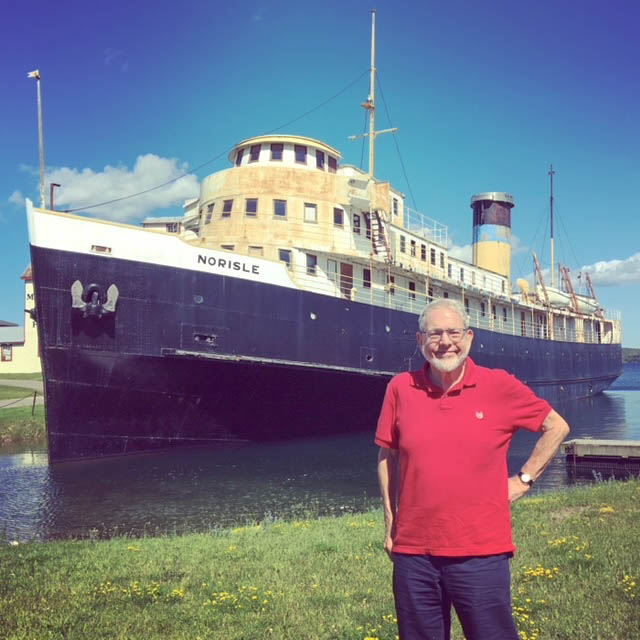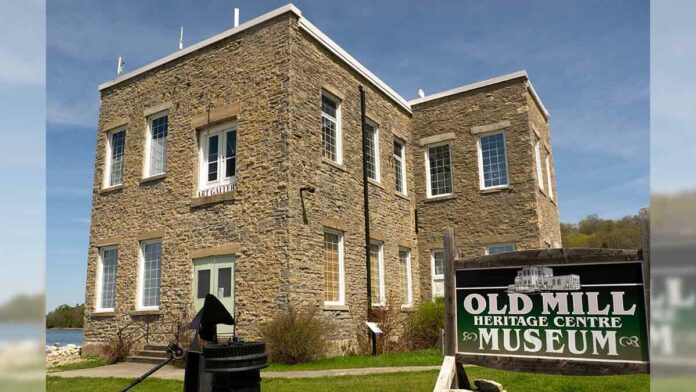Don Stevenson spent his Grade 13 summer working on the ship
TORONTO—Last week’s departure of the S.S. Norisle from Manitowaning Bay was a “very sad” occasion for Toronto’s Don Stevenson, who worked as a deckhand on the ship in his youth.
Mr. Stevenson, now 89, spent the summer of 1952 aboard the Norisle as an 18-year-old. He grew up in Owen Sound and his father, who worked as a high school teacher in the community, also spent his summers working on the ship.
Mr. Stevenson had an even earlier start to his nautical career. At just 10 years old in 1944, his father invited him to work together aboard the S.S. Caribou. That ship was on the ‘Turkey Trail’ between Owen Sound and Michipicoten Harbour, via the North Channel of Lake Huron.
While his father served as the ship’s purser, the one in charge of administrative tasks like hiring waiters and pantry boys, Mr. Stevenson was assigned to run the tuck shop.
“A lot of the passengers were Americans, so I had a good lesson in arithmetic because the US dollar was about $1.10 on the Canadian dollar,” said Mr. Stevenson.
He said he fondly remembers the stops at the various points along the route. They included Killarney, Manitowaning, Little Current, Kagawong, Gore Bay and Meldrum Bay.
The Norisle, launched in 1946, was the first passenger ship built in Collingwood after the war. Although Mr. Stevenson did not witness the launch of the ship he would eventually work on, he did see the launch of the corvette HMCS Owen Sound in 1943, then the launch of the Chi-Cheemaun in 1974.
***
The summer aboard the Caribou was a one-off until 1952. Mr. Stevenson was in his Grade 13 year and worked as the circulation manager for Eddie Sargent’s weekly newspaper. (Mr. Sargent was also the mayor of Owen Sound from 1948 to 1963, then represented the area in the Ontario legislature from 1963 to 1987.)
Mr. Sargent’s brother happened to be the secretary-treasurer of the Owen Sound Transportation Company. Mr. Stevenson approached him and enquired about a position with the shipping company.
“He said, ‘yes, if you can get to Tobermory tomorrow, you can be a deckhand,’” Mr. Stevenson recalled.
This was a very different assignment than his boyhood shifts running the tuck shop, and it was also different from Mr. Stevenson’s brother, who worked as a waiter on the S.S. Norgoma.
“I enjoyed working there, but it was tough work sometimes. The ferry went 20 miles one direction and 20 in the other. On rough days it rolled one way half the time, half the time it rolled the other. A lot of passengers got sick, so we spent a lot of time cleaning up,” he said.
This was just one season among a series of summers working in various trades, something Mr. Stevenson did as a way to get more world experience beyond his years in a classroom.
Unlike his positions at an E.B. Eddy fine paper mill in the Ottawa area and working in a sawmill at a lumber camp near Red Lake, the seasoned workers on the Norisle were kind to the greenhorns and took time to teach them their craft.
“I remember the Norisle with fonder memories,” he said, despite the difficulty of some of the jobs he did aboard the ship.
“My parents came up to see me once but they didn’t even recognize me because I had been shoveling coal. My face was all black from that, and there was also lots of smoke in those days,” said Mr. Stevenson.
The last time he set foot on the Norisle was in 1954, while heading from a summer job in Northern Ontario to a position at the Canadian National Exhibition in Toronto.
***
As he grew up, ships faded from his life. Mr. Stevenson became involved in politics, serving as a deputy minister in the Ontario government for portfolios including resource development, municipal affairs and intergovernmental relations. He also worked in the US section of external affairs and in Canadian embassies overseas.
The Norisle was all but a distant memory for Mr. Stevenson until 2017, when his daughter and son-in-law took him on a circle tour of Georgian Bay. When they arrived in Manitowaning, he was shocked to see the Norisle waiting for him in the harbour.
“There was a banner up on top that said ‘Sesquicentennial Restoration Project.’ The Norisle looked fine to me, though it was listing a bit,” he said.
Someone on the shore told Mr. Stevenson that the restoration had stalled some months earlier, a disappointing revelation.
As they continued their circle tour via the Chi-Cheemaun, Mr. Stevenson was invited into the wheelhouse to briefly steer the ship, a point of pride for the former mariner.
“With that, I had something to do with three generations of OSTC ships,” he said.
***
When this reporter broke the news to Mr. Stevenson that the Norisle had left her berth in Manitowaning, he paused before simply saying, “oh my.”
Mr. Stevenson had recently heard of the plans to scrap the historic ferry and was trying to work his connections at Queen’s Park to save the ship.
“It is certainly a big part of our Great Lakes history,” he said. “I think there’s a big missed opportunity here. And also disrespect for our heritage, our maritime heritage.”
He wrote a letter to the editor in the Toronto Star in defense of saving the ship, and also reached out to some connections in the Ontario Legislature. However, the government contacts did not come through as hoped.
“I feel bad that I’m just a bit too out of touch at Queen’s Park now,” said Mr. Stevenson, who retired from Ontario politics 34 years ago. He contacted the premier’s office directly, but only heard an acknowledgement after the ship had left her berth.
“I had difficulty really getting anybody to pay much attention,” he said.
Mr. Stevenson says he still has hope that something may happen to save the ship before the lighting of the scrappers’ torches. Until then, his memories and stories of working aboard the Norisle will carry forward a small part of its legacy.





